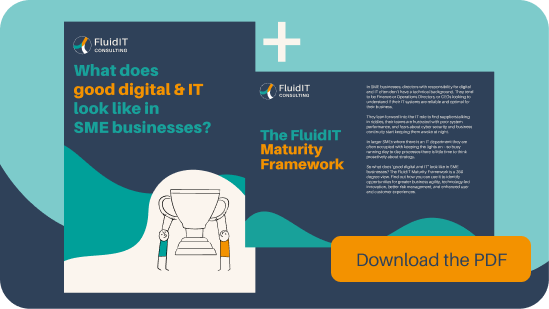It is more important than ever to have a digital and IT strategy that aligns to the business strategy. SME businesses also need to be able to execute change effectively and to manage digital and IT risks proactively, but often lack dedicated project delivery resources.
Competitive SMEs can look to solve resourcing issues by partnering with a consultancy that offers a mix of capabilities, from fractional IT Directors to hands-on delivery help from project managers, business analysts, technical architects, and software developers. SME businesses that have a digital and IT strategy aligned to business outcomes, supported by a multidisciplinary digital transformation partner, are able to execute change faster and with better results, powering them ahead of the competition.
73% of SMEs indicated at least one issue relating to implementation, including set up and implementation of new technologies, integration with existing technologies and business processes, migration from previous systems and decommissioning old technologies*.
Key questions to ask of the business
- Is there a digital and IT strategy that enables business growth?
- Does the business have the capability and capacity to deliver change?
- Does the business have adequate change governance in place?
What does digital often look like in average SMEs?
Responsibility for digital and IT strategy often falls to a busy director who has limited capacity and little or no technical experience. In many cases, the digital strategy is a distraction from their core responsibilities. There may not be a digital and IT plan for delivery, and there may only be an informal understanding of priorities at senior level.
51% of SMEs indicated at least one issue relating to planning or initiating their digital transformation, such as defining their requirements, selecting the right products or technologies,
or choosing suppliers*.
While the director(s) may have support from senior managers, there are often no dedicated project delivery resources. This means that change delivery tends to be ad-hoc and slow and the business lacks governance such as a formal change management or IT steering forum. As a result, technology risks, issues and opportunities aren’t being tracked or managed.
What does good look like?
It is not enough to have a standalone digital and IT strategy and plan. They need to be integrated with the business plan and aligned around business goals, so that technology investment is clearly linked to business benefits.
The most digitalised businesses have highlighted new business opportunities at more than double the rate of the least digitalised*.
More mature SMEs work with third party part-time or fractional project delivery resources to deliver change quickly and incrementally, or they begin to grow their own capability. You’ll also see greater adoption of formal project governance and planning supported by business cases, for an increasing range of projects. Formal IT steering and change management forums will be established and chaired by directors, through which progress of the digital and IT roadmap delivery will be monitored, and all technology risks tracked and proactively managed.
The most mature SMEs are regularly scanning the environment for the latest technologies and solutions and incorporating relevant ones into their agile, and continuously evolving digital and IT roadmap. Their digitally inspired business strategies are helping them enter new markets, with new digital products and services, transforming customer experience and operating models, and achieving transformational growth as a result.
* SME Digitalisation - Vodafone

There was a lot of enthusiasm and people came away with engagement in the process and commitment to implement it. It moved up people’s priorities and became a project with a timeline. There was real traction. I wasn’t expecting that level of enthusiasm from an IT project.
Daniel Whittle, Whitby Seafoods Managing Direct or
Whitby Seafoods is world famous in Yorkshire. In 2019 the business was the fastest growing coated seafood brand in the UK, thanks to their ethos of continuous improvement and investment in their products, factory and people. In 2020 Whitby Seafoods started working with Fluid to activate a stalled digital transformation programme. In visual strategy workshops the team arrived at consensus on priority initiatives across data, business systems, IT and resources. After five months the revitalised change programme had already freed up £500,000 of raw material funding.
Read the case study:
Igniting digital transformation with lightbulb moments
Read the Case Study
